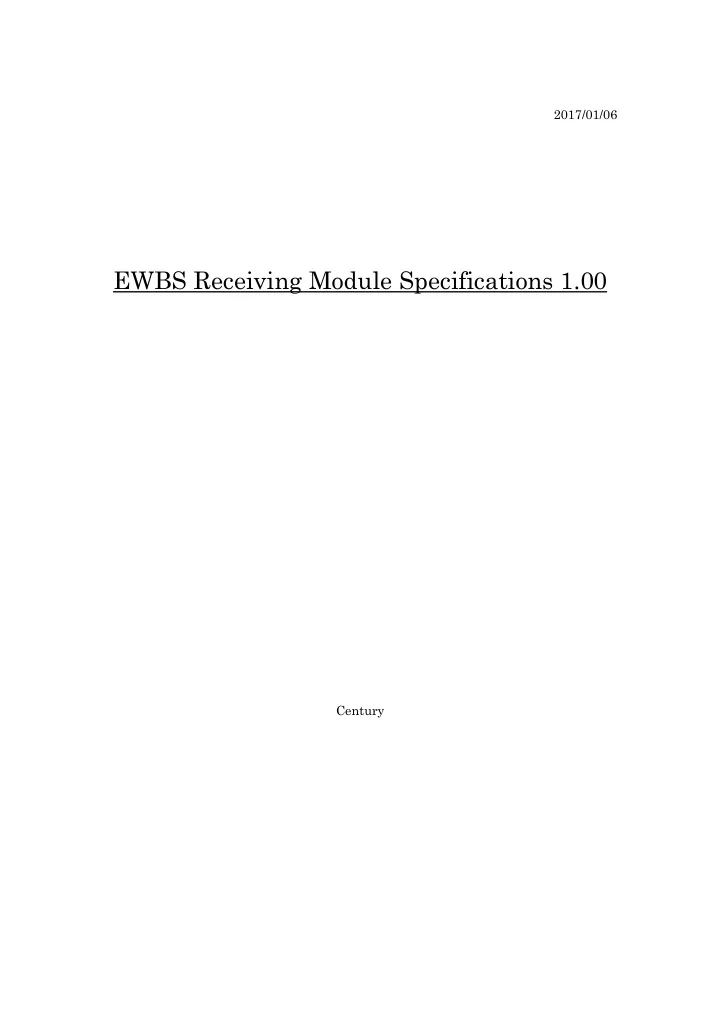

2017/01/06 EWBS Receiving Module Specifications 1.00 Century
Revision history Revision history Revision Date Changes Remarks 1.00 2017/01/06 Initial Release.
1. Overview EWBS Receiving Module embed One-seg ISDB-T tuner and receive EWBS signals and output character code of Superimpose text message in EWBS signals. 2. Functions ① Embedded One-seg ISDB-T tuner and receive EWBS signals. (Output character code of Superimpose text message in EWBS signals). Maximum sizes of text data: 120bytes ② Supported frequency range: 470 to 806MHz(UHF-band) Supported bandwidth system of ISDB-T 6MHz and 8MHz. ③ Rated input voltage : 3.3V DC +/-5% ④ Host interface : Asynchronous serial communication ⑤ Firmware update can be available through USB interface. Switching bandwidth system must be updated to the firmware. ⑥ Compatible with EWBS "Area code" function. When Area code is not set, module works every time of EWBS operation (regardless of Area code in EWBS signal) ⑦ Area code and Monitoring frequency need to be set either by PC through USB or by UART. ⑧ Output of "Sound-control" in EWBS signal. ⑨ Monitoring function of RF reception strength.
3. Pin assignment 25.00 18 17 1 16 2 15 3 14 4 13 5 12 6 11 7 10 8 9 19
4. Pin functions Pin No. Symbol Out/In Function SOUND It is a sound control terminal. It becomes High level 1 CONTROL Out when receiving the sound output signal included in the OUT EWBS signal. 2 NC 3 TX Out Serial output pin 4 RX In Serial input pin 5 NC 6 NC 7 NC 8 Vss In Ground pin.Connect to the system power supply (0V). 9 NC 10 NC EWBS EWBS advertised pin.While receiving EWBS signal, it 11 Out OUT become high level. Power save mode pin.When this pin set to low level, 12 /SLEEP In module become power saving mode while the EWBS signal is not received. Reset Pin.When this pin is set to low level, reset state 13 /RESET In is entered. 14 NC 15 NC 16 Vcc In Power pin.Connect to the system power supply (3.3V). 17 Vss In Ground pin.Connect to the system power supply (0V). 18 ANT In Antenna input pin. In/Out It is a USB terminal used for firmware update, setting, 19 USB etc. ① SOUND CONTROL OUT pin It becomes High level when receiving the sound output signal included in the EWBS signal. ② EWBS OUT Pin Signal level becomes high when EWBS signal start receiving. If area code is set, it becomes high level only when area code is corresponded.
③ /SLEEP Pin When it is set to the LOW level, it enters the power saving mode until it receives the EWBS signal. In the power saving mode, it does not respond to any commands in asynchronous serial from the host. When set to High level, it returns to normal state in power saving mode.
5. Host interface The host system can acquire EWBS information by using this module. ① Serial communication specifications Asynchronous serial 115,200bps, 8bit 1 Stop bit, Non Parity, no flow control, signal level TTL. ② Command specifications Please refer to EWBS Receiving Module Communication specifications.
6. Electrical characteristics ① Absolute maximum ratings Item Symbol Min Max Unit Supply voltage Vdd -0.3 4 V Input terminal supply Vin -0.3 4 V voltage Ambient operating Ta -40 85 ℃ temperature ② Recommended operating conditions Item Symbol Min Typ Max Unit Supply voltage Vdd 2.5 3.3 3.6 V Input terminal Vin -0.3 3.3 3.6 V supply voltage ③ Current consumption (Ta=25 ℃ , VCC=3.3V) Item Condition Min Typ Max Unit EWBS receiving 75 mA Current consumption Power saving mode 58 mA ④ DC characteristics (Ta=25 ℃ , VCC=3.3V) Item Symbol Min Max Unit High Vih 2.3 V Terminal input voltage Low Vil 0.9 V High Voh 0.4 V Terminal output voltage Low Vol 2.4 V
7. RF Characteristics (Ta=25 ℃ , VCC=3.3V) Item Symbol Min Typ Max Unit RF Frequency Range fUHF 470 806 MHz RF Input Impedance Zin 50* Ω Input VSWR VSWR 3:01 Sensitivity Pmin -99 dBm Max Input Level Pmax 13 dBm Lower Digital Adjacent DACS N+1 51 dB Channel Selectivity Upper Digital Adjacent DACS N-1 51 dB Channel Selectivity CNR Performance at C/N 4.5 dB AWGN condition Multipath Fading 250 Hz (Max Doppler frequency) ※ Impedance conversion is necessary when using 75 Ω receiving antenna.
8. Recommended pad pattern
9. Circuit
� � � � � � � -%#� -%#� �-/�(��� �-/�(��� �-/�(��� �-/�(��0 �-/�(��0 �-/�(��0 �-/�(�"�/ �-/�(�"�/ �-/�(�"�/ �-/�(�/�" � � �-/�(�/�" �-/�(�/�" +12(/�& +12(/�& +12(/�& +12()� +12()� +12()� -%#�(&+�)� -%#� /���(*- /���(*- /���(*- /���(��, /���(��, /���(��, /���(��� /���(��� /���(��� -%#�())-�"� -%#�(�/�"� � -%#� � -%#�(����.��� � � &'()*��(�"�+,) &'()*��(�"�+,) &'()*��(�"�+,) ���� ���� ���� ��������������� ��������������� ��������������� ��� ��� ��� �� �� �� &'()*��(�"�+,) &'()*��(�"�+,) &'()*��(�"�+,) #%#� #%#� #%#� ����� ����� ����� ����� !�"���������!��#�$ ����� !�"���������!��#�$ ����� !�"���������!��#�$ ����� ����� ����� � � � �� �� �� � � � � � � � �
Recommend
More recommend